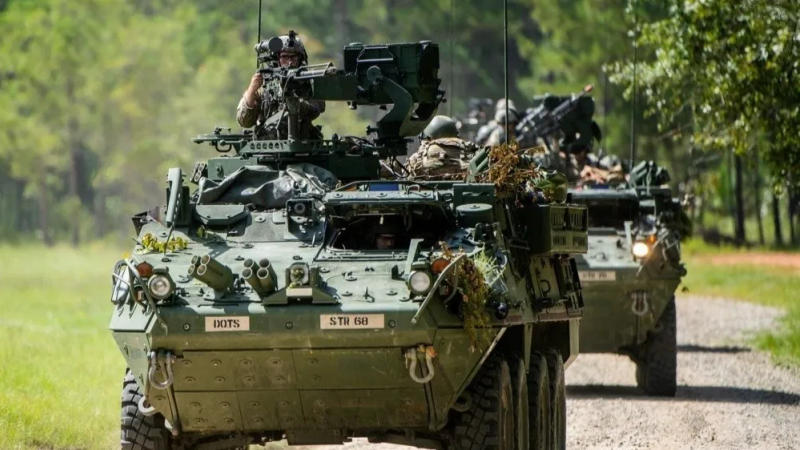Published 17:23 IST, November 29th 2023
US offers Stryker armoured vehicles with air defence capabilities for the Indian Army
The proposal includes the possibility of co-producing these advanced vehicles in collaboration with Indian entities.

In a strategic move, the US government has extended an offer to provide Stryker armoured fighting vehicles, equipped with air defence systems, to the Indian military. Defence officials revealed that the proposal includes the possibility of co-producing these advanced vehicles in collaboration with Indian entities. This offer was prominently raised during the 2+2 dialogue between India and the US, with Defence Secretary Lloyd J Austin formally announcing the push for co-production.
This isn't the first instance of the US advocating the sale of Stryker systems to India. Similar proposals have been presented in recent high-level meetings with Indian establishments. While India is actively considering the offer, sources in the security establishment indicate that no final decision has been reached.
Why is the timing strategic?
The American proposition comes at a time when the Indian defence industry has demonstrated significant progress in developing armoured combat vehicles. Projects like the Wheeled Armoured Platform, developed by the Defence Research and Development Organisation in collaboration with private industry, exemplify India's commitment to enhancing its indigenous defence capabilities. Notably, Indian private firms, including Bharat Forge and Tata, have actively contributed by manufacturing and supplying systems deployed in forward areas, such as the sensitive Ladakh sector along the China border.
The Stryker, a versatile family of eight-wheeled armoured fighting vehicles, has its roots in the Canadian LAV III. Manufactured by General Dynamics Land Systems-Canada for the United States Army in Ontario, it features four-wheel drive (8×4) that can be switched to all-wheel drive (8×8).
Key Features:
Originally conceived as the backbone of a new medium-weight brigade combat team (BCT), the Stryker was selected through the Interim Armored Vehicle competition in 2000. Its primary armament is a Protector M151 Remote Weapon Station, offering flexibility with .50 in (12.7 mm) M2 machine guns, 7.62 mm M240B machine guns, or 40 mm Mk 19 grenade launchers.

- Adapting to Air Defence: Significantly, the Stryker's adaptability extends to air defence capabilities. In September 2017, Raytheon demonstrated the integration of Stinger missiles into a Stryker-mounted Common Remotely Operated Weapon Station (CROWS), effectively turning the vehicle into a short-range air defence system. The Army is actively considering this capability, which, if selected, could be rapidly fielded within two years.
- Operational Mobility: In August 2018, 86 Strykers began fielding with a CROWS turret adapted to fit an FGM-148 Javelin tube, allowing the vehicle to fire the weapon without requiring dismounted troops. Operational mobility requirements, outlined as part of the army's transformation plan, highlight the Stryker's ability to deploy rapidly worldwide, aligning with the objective of readiness within specific timelines. This proposal holds the potential to strengthen the strategic collaboration between the US and India in the realm of advanced armoured vehicles.
- 360-Degree Vision: Periscopes for the driver and vehicle commander, who also serves as the gunner, contribute to an impressive field of vision. The vehicle commander, armed with a day-night thermal imaging camera, enjoys nearly a 360-degree view, while the driver's vision extends just beyond 90 degrees, collectively providing comprehensive visibility.
- Immersive Training Within the Vehicle: Soldiers can engage in training exercises using computer training modules integrated within the vehicle, enhancing their proficiency with the Stryker. Ongoing developments by General Dynamics Land Systems aim to introduce a new Power and Data Management Architecture for seamless integration of computer upgrades.
- Extended Range Thermal Sights: The Stryker's thermal sights set a new standard with an impressive range of up to 7,800 feet. This capability surpasses traditional night vision sights, allowing the vehicle to warn dismounted soldiers of threats beyond the range of their night vision equipment.
While the Stryker has faced criticism in the ongoing debate between tracked and wheeled vehicles, the US Army's decision reflects a preference for agility and speed. Wheeled vehicles are easier to maintain and offer higher road speeds, aligning with the military's commitment to innovation for enhanced operational effectiveness. The Stryker remains a testament to the military's dedication to adopting cutting-edge technologies on the modern battlefield.
Updated 17:23 IST, November 29th 2023




